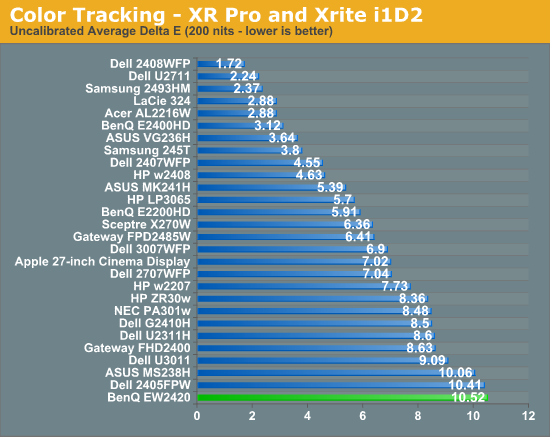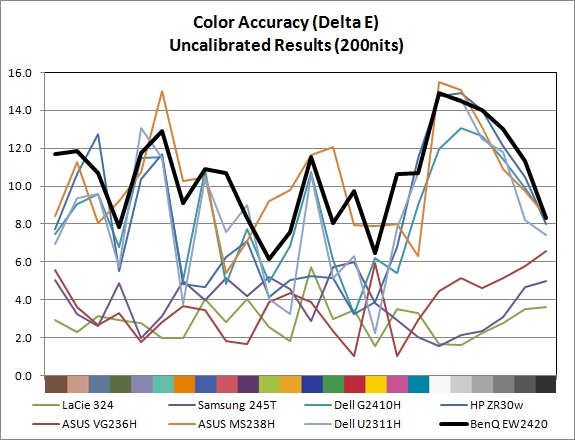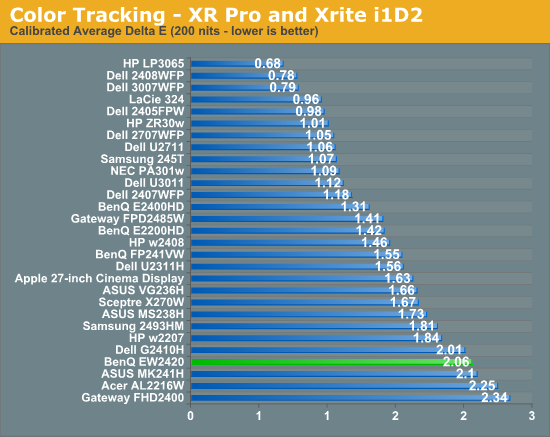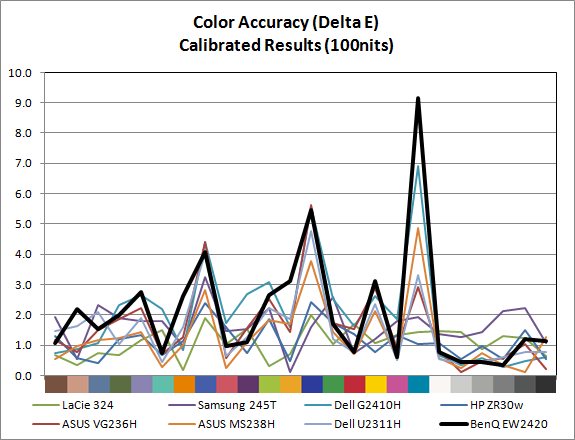BenQ EW2420 Monitor Review
by Chris Heinonen on October 13, 2011 12:00 AM ESTViewing Angles
With it’s VA panel, the BenQ looks better at off angle viewing than a TN display would, though not quite as good as an IPS panel can. Moving off-angle you begin to get an image that washes out a bit, but not the color shifts that are common to TN panels. Moving as little as 15-20% off to the side can lead to the loss of color so I would recommend keeping the monitor as close to lined up directly with your eyes as possible. The stand only has tilt adjust, so if you need height or swivel support to keep it in line, you might want to consider a different stand or mount that can use the 100mm VESA mounting holes.
Color Quality
With a VA panel and LED lighting, the BenQ EW2420 seemingly has everything in place to produce a very good image. Using the included profile, we find a Delta E (dE) of over 10 with the highest levels of error coming in the grayscale, where we least want them to occur.


Using ColorEyes Display Pro, we set our calibration target for a D65 white point, 2.2 gamma, and 200 nits of light output. We are using an i1Display2 meter for our measurements and making sure to give the display an hour to stabilize in readings. The BenQ EW2420 supports DDC controls so I attempted to calibrate using DDC and to calibrate manually using the RGB gain controls available to the user in Standard mode. The difference between the two methods resulted in a dE difference of 0.04, well within any margin of error, so I used the DDC mode since the results were as good, and the easier method is more likely to be used.


After calibration we see that the dE was moved from over 10 down to just over 2. A closer look at the individual calibration numbers show that the grayscale tracks very well at the points measured, and the colors in the GMB color checker that are producing most of the error are heavily weighted towards blue. Additionally one of the samples in the GMB color checker, a shade of cyan, falls outside of the sRGB gamut so monitors that can’t do the AdobeRGB color space are always going to produce a large error on that sample.
Blue color errors are both preferable to other color errors as our eyes are less sensitive to them than to errors in red or green. This is another reason to pay close attention to the detailed breakdown of the dE number and not just focus on the overall number.


With 100 nits, we see very similar performance, though the dE in the grayscale goes up at the lower end of it. As mentioned before, this could be due in part to darker output levels than the 200 nits result leading to measurement errors.















47 Comments
View All Comments
dcollins - Thursday, October 13, 2011 - link
That makes absolutely no sense. How could less resolution in the same size possibly be worse for working? You get more vertical and horizontal space.mi1stormilst - Thursday, October 13, 2011 - link
It seems to me that it is really hard to make choices about which monitors are the best for gaming and photo editing below $400.00. What I want is a good IPS or VA based monitor that is great on color reproduction, but fast enough to game with and then pair it with two decent TN based panels (sides) for some fun eyefinity stuff. I need to replay Deus Ex in triple portrait mode soon or I am going to go crazy ;-PLordSojar - Thursday, October 13, 2011 - link
The choice is actually very easy....The ASUS PA246Q is by far the best gaming and photo editing monitor available, period. Turn off trace completely for gaming and you've got one wicked gaming monitor... and it's 98% Adobe RBG space. I own one, and will NEVER go back to any TN garbage nor will I ever "upgrade" to a 16:9 monitor that has an IPS panel. Blasphemy!
Death666Angel - Thursday, October 13, 2011 - link
That monitor should be a few bucks over $400 though.mobutu - Thursday, October 13, 2011 - link
People really should educate themselves and never ever buy crappy TN.In notebooks/laptops/nettops/ultrabooks too. Crappy TN with crappy Glossy ... yuck!
dcollins - Thursday, October 13, 2011 - link
I don't do print or serious color work, don't play first person shooters, and only use my monitor sitting in the same spot at my desk.I can get a 23" Acer TN panel monitor for $150 that serves my needs. Why waste $200 on features I do not need?
cactusdog - Thursday, October 13, 2011 - link
People should educate themselves about changes in the computer industry and changes in technology, instead of regurgitating old out of date information from 2004.120Hz is the new must have for gamers and will be standard kit within the next year or so. Only people who never tried a 120Hz say they will only use 60Hz IPS.
I know guys selling their U2711's for SA950's thats how good they are.
Death666Angel - Thursday, October 13, 2011 - link
"The BenQ EW2420 has LED backlighting but still only covers the standard sRGB colorspace"That reads a bit strange (though not wrong). As far as I know, normal LED backlighting has inferior color range than CCFL (which is used in most wide-gamut and professional monitors). The only way for LED to offer competitive color range is to use RGB LEDs. Your statement above makes it sound as though LED generally has superior color range, but just this one monitor doesn't make use of it. :-) Or am I wrong?
Otherwise, I don't see the appeal in 1080p @ 24". But good review!
cheinonen - Thursday, October 13, 2011 - link
Correct. I know many people that see LED backlighting and think "Oh, it has a wider color spectrum then!" since many of the initial LED displays did use RGB LEDs to have that larger spectrum, or at least promoted it as a major feature of being LED based. I just wanted to be clear that it wasn't the case here. It's always a fine line between assuming too much or too little when you try to figure out how detailed to be on every point.dingetje - Thursday, October 13, 2011 - link
no thanks BENQ....16:9 panels are crap